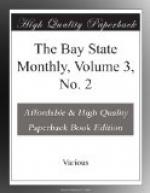The White Mountain Notch, after Mount Washington, is the great natural feature of the range. For three miles the road follows the bottom of a chasm between overhanging cliffs, in some places two thousand feet in height, and at others not more than twenty-five feet apart. This is the great thoroughfare of travel, from the northern towns on the Connecticut to Conway and the Saco valley, and vice versa; and through it pass the headwaters of the Saco, which afterwards broadens out into a great river, and flows with rapid course through the loveliest of valleys to the sea. Much of the natural wildness and grandeur of the pass has been destroyed by laying the line of the Portland and Ogdensburg Railroad, which has been graded through the ravine. Railroads serve a great utilitarian purpose, but they have their defects; it seems out of place to ride across Egypt or the Holy Land behind a locomotive; a prancing steed or a camel with tinkling bells seems the most fitting motive power. There is nothing sentimental about a railroad, but after all who would care to return to the old methods of locomotion?
The Willey House, famous in story, stands upon the Notch road nestling under the steep acclivity of Mount Willey, which rises some two thousand feet behind the house.
“Why don’t some of our authors use more of the historical material of this region in story writing than they do?” asked Fritz.
“The material is so romantic that romance can add nothing to it,” answered Molly. “But you forget Hawthorne. His Ambitious Guest has imparted a weird interest to the event. He makes a young man, travelling through the Notch, partake of the hospitality of the family on the fatal night. At the fireside they fall to talking of their individual plans, the guest expressing himself as desirious of achieving fame. It seemed a terrible thing to him to die and to be forgotten, to leave no name behind and no monument to mark his resting place. In the midst of the conversation the ruin came, and the ambitious guest, flying with the family, found his burial with the others. The story will live in Hawthorne long after the true facts have been forgotten; or they will live because Hawthorne’s narrative will have conferred immortality upon them.”
This memorable event happened on the night of Monday, the twenty-eighth of August, 1826. A terrible storm of wind and rain prevailed, the mountain branches of the Saco and the Ammonoosuc speedily overfilled their rocky channels, and the steep sides of hills loosened by the rain swept down upon the valleys, destroying many an ancient landmark. One of these slides swept down toward the Willey House, then occupied by Samuel Willey, his wife, and family. The frightened inmates, seeking safety by flight from the impending ruin, were overwhelmed by the avalanche and perished, while the house remained untouched. The bodies of two sons and one daughter were never found; the rest of the Willey household lie buried in a small cemetery enclosure near the mansion house of Willey Farm at North Conway.




